Auditing Theory and Practice: Solutions to Case Studies
VerifiedAdded on 2022/10/10
|15
|3386
|200
AI Summary
This document provides solutions to three case studies related to auditing theory and practice. It discusses inherent risks involved in the audit of MaxSecurity, weaknesses and strengths associated with debtor confirmation, and ethical issues faced by Meg. It also suggests appropriate courses of action and reporting options for each case.
Contribute Materials
Your contribution can guide someone’s learning journey. Share your
documents today.
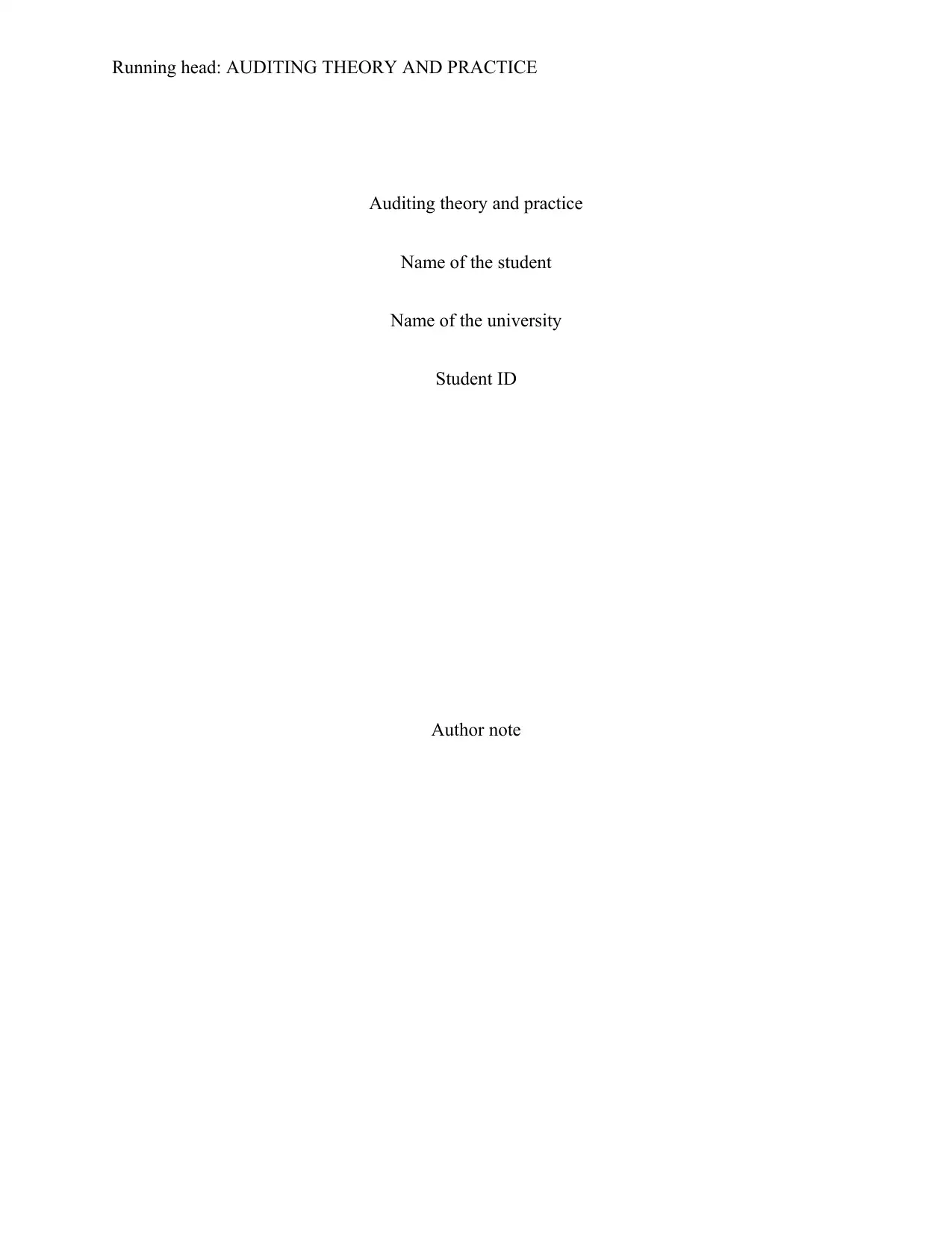
Running head: AUDITING THEORY AND PRACTICE
Auditing theory and practice
Name of the student
Name of the university
Student ID
Author note
Auditing theory and practice
Name of the student
Name of the university
Student ID
Author note
Secure Best Marks with AI Grader
Need help grading? Try our AI Grader for instant feedback on your assignments.
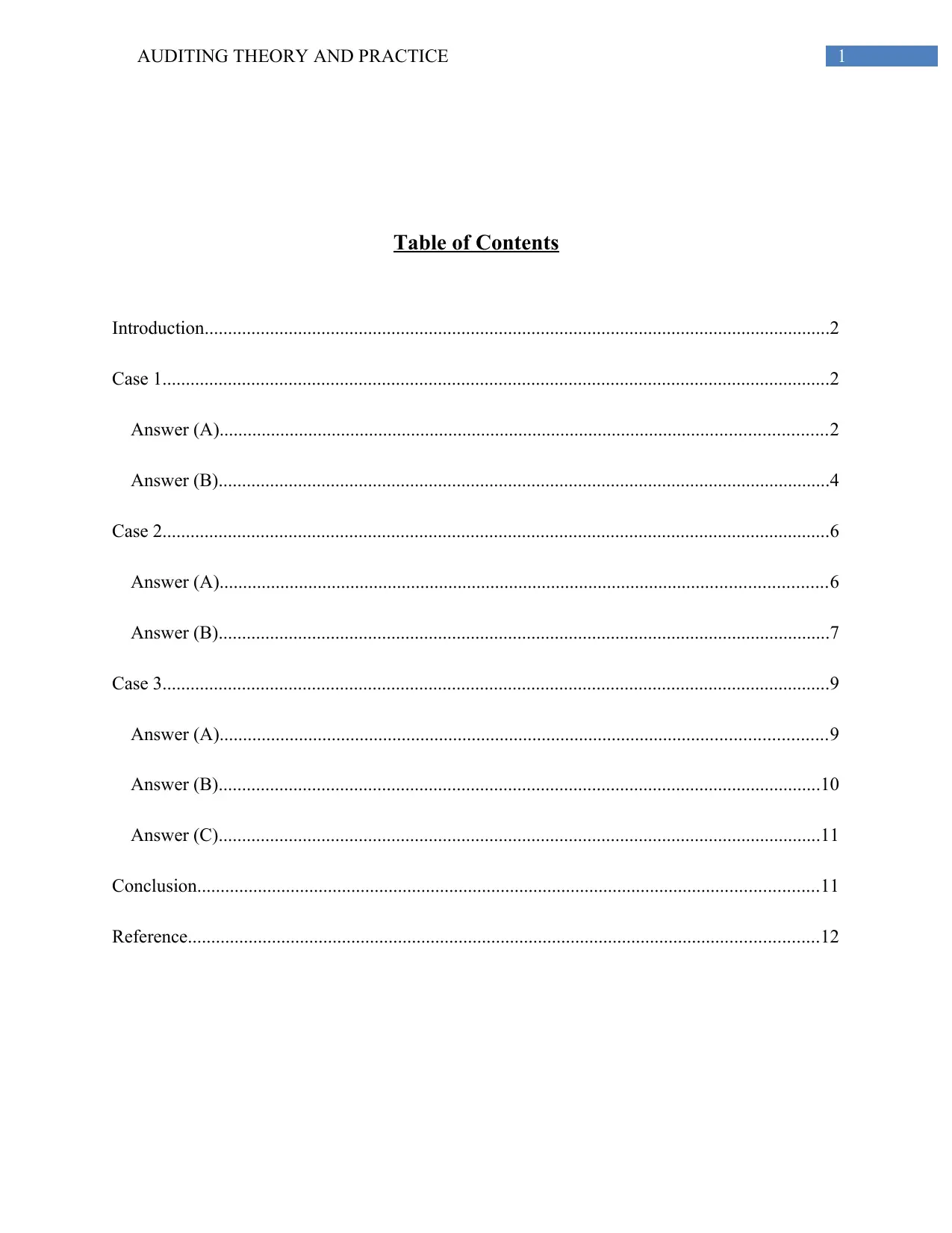
1AUDITING THEORY AND PRACTICE
Table of Contents
Introduction......................................................................................................................................2
Case 1...............................................................................................................................................2
Answer (A)..................................................................................................................................2
Answer (B)...................................................................................................................................4
Case 2...............................................................................................................................................6
Answer (A)..................................................................................................................................6
Answer (B)...................................................................................................................................7
Case 3...............................................................................................................................................9
Answer (A)..................................................................................................................................9
Answer (B).................................................................................................................................10
Answer (C).................................................................................................................................11
Conclusion.....................................................................................................................................11
Reference.......................................................................................................................................12
Table of Contents
Introduction......................................................................................................................................2
Case 1...............................................................................................................................................2
Answer (A)..................................................................................................................................2
Answer (B)...................................................................................................................................4
Case 2...............................................................................................................................................6
Answer (A)..................................................................................................................................6
Answer (B)...................................................................................................................................7
Case 3...............................................................................................................................................9
Answer (A)..................................................................................................................................9
Answer (B).................................................................................................................................10
Answer (C).................................................................................................................................11
Conclusion.....................................................................................................................................11
Reference.......................................................................................................................................12
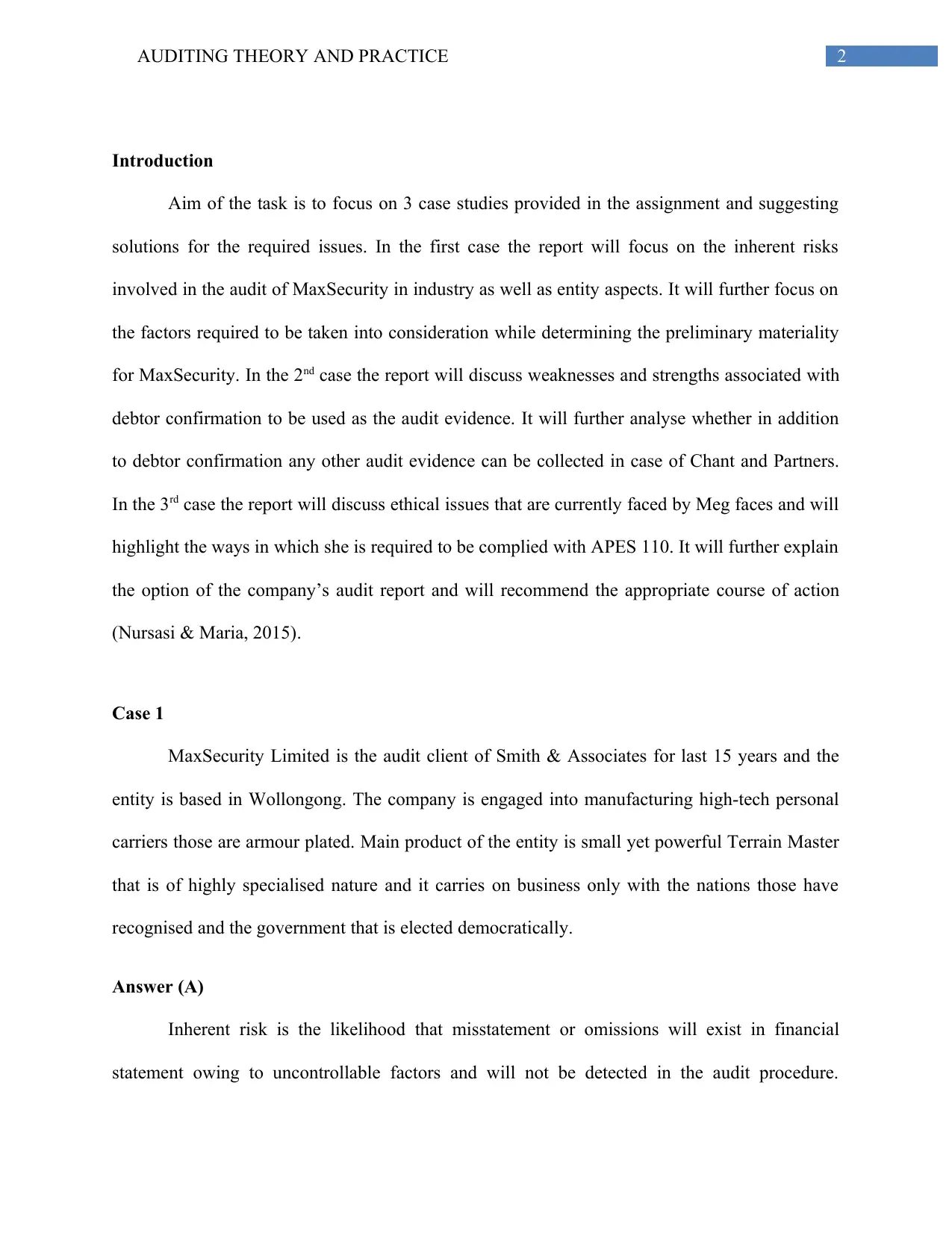
2AUDITING THEORY AND PRACTICE
Introduction
Aim of the task is to focus on 3 case studies provided in the assignment and suggesting
solutions for the required issues. In the first case the report will focus on the inherent risks
involved in the audit of MaxSecurity in industry as well as entity aspects. It will further focus on
the factors required to be taken into consideration while determining the preliminary materiality
for MaxSecurity. In the 2nd case the report will discuss weaknesses and strengths associated with
debtor confirmation to be used as the audit evidence. It will further analyse whether in addition
to debtor confirmation any other audit evidence can be collected in case of Chant and Partners.
In the 3rd case the report will discuss ethical issues that are currently faced by Meg faces and will
highlight the ways in which she is required to be complied with APES 110. It will further explain
the option of the company’s audit report and will recommend the appropriate course of action
(Nursasi & Maria, 2015).
Case 1
MaxSecurity Limited is the audit client of Smith & Associates for last 15 years and the
entity is based in Wollongong. The company is engaged into manufacturing high-tech personal
carriers those are armour plated. Main product of the entity is small yet powerful Terrain Master
that is of highly specialised nature and it carries on business only with the nations those have
recognised and the government that is elected democratically.
Answer (A)
Inherent risk is the likelihood that misstatement or omissions will exist in financial
statement owing to uncontrollable factors and will not be detected in the audit procedure.
Introduction
Aim of the task is to focus on 3 case studies provided in the assignment and suggesting
solutions for the required issues. In the first case the report will focus on the inherent risks
involved in the audit of MaxSecurity in industry as well as entity aspects. It will further focus on
the factors required to be taken into consideration while determining the preliminary materiality
for MaxSecurity. In the 2nd case the report will discuss weaknesses and strengths associated with
debtor confirmation to be used as the audit evidence. It will further analyse whether in addition
to debtor confirmation any other audit evidence can be collected in case of Chant and Partners.
In the 3rd case the report will discuss ethical issues that are currently faced by Meg faces and will
highlight the ways in which she is required to be complied with APES 110. It will further explain
the option of the company’s audit report and will recommend the appropriate course of action
(Nursasi & Maria, 2015).
Case 1
MaxSecurity Limited is the audit client of Smith & Associates for last 15 years and the
entity is based in Wollongong. The company is engaged into manufacturing high-tech personal
carriers those are armour plated. Main product of the entity is small yet powerful Terrain Master
that is of highly specialised nature and it carries on business only with the nations those have
recognised and the government that is elected democratically.
Answer (A)
Inherent risk is the likelihood that misstatement or omissions will exist in financial
statement owing to uncontrollable factors and will not be detected in the audit procedure.
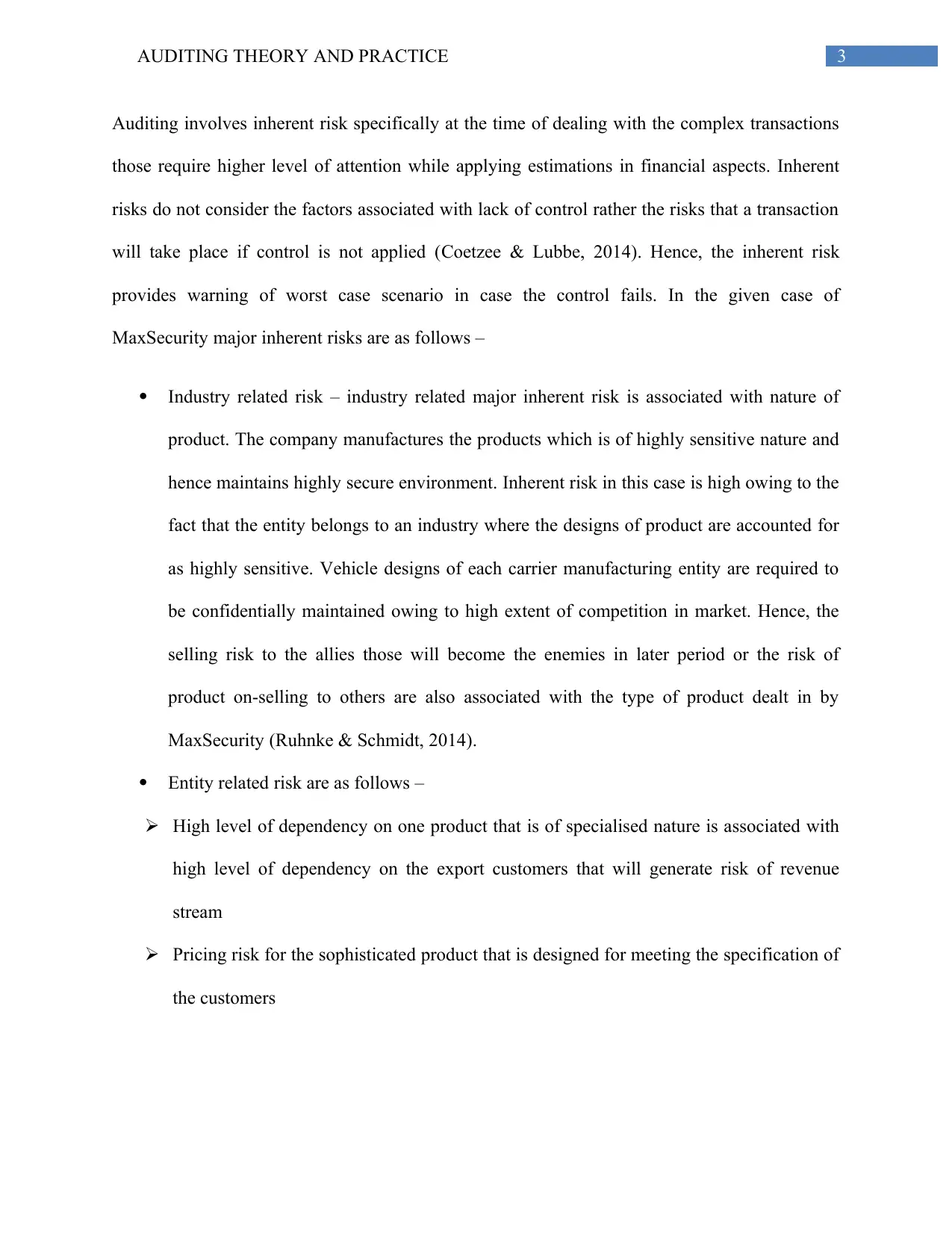
3AUDITING THEORY AND PRACTICE
Auditing involves inherent risk specifically at the time of dealing with the complex transactions
those require higher level of attention while applying estimations in financial aspects. Inherent
risks do not consider the factors associated with lack of control rather the risks that a transaction
will take place if control is not applied (Coetzee & Lubbe, 2014). Hence, the inherent risk
provides warning of worst case scenario in case the control fails. In the given case of
MaxSecurity major inherent risks are as follows –
Industry related risk – industry related major inherent risk is associated with nature of
product. The company manufactures the products which is of highly sensitive nature and
hence maintains highly secure environment. Inherent risk in this case is high owing to the
fact that the entity belongs to an industry where the designs of product are accounted for
as highly sensitive. Vehicle designs of each carrier manufacturing entity are required to
be confidentially maintained owing to high extent of competition in market. Hence, the
selling risk to the allies those will become the enemies in later period or the risk of
product on-selling to others are also associated with the type of product dealt in by
MaxSecurity (Ruhnke & Schmidt, 2014).
Entity related risk are as follows –
High level of dependency on one product that is of specialised nature is associated with
high level of dependency on the export customers that will generate risk of revenue
stream
Pricing risk for the sophisticated product that is designed for meeting the specification of
the customers
Auditing involves inherent risk specifically at the time of dealing with the complex transactions
those require higher level of attention while applying estimations in financial aspects. Inherent
risks do not consider the factors associated with lack of control rather the risks that a transaction
will take place if control is not applied (Coetzee & Lubbe, 2014). Hence, the inherent risk
provides warning of worst case scenario in case the control fails. In the given case of
MaxSecurity major inherent risks are as follows –
Industry related risk – industry related major inherent risk is associated with nature of
product. The company manufactures the products which is of highly sensitive nature and
hence maintains highly secure environment. Inherent risk in this case is high owing to the
fact that the entity belongs to an industry where the designs of product are accounted for
as highly sensitive. Vehicle designs of each carrier manufacturing entity are required to
be confidentially maintained owing to high extent of competition in market. Hence, the
selling risk to the allies those will become the enemies in later period or the risk of
product on-selling to others are also associated with the type of product dealt in by
MaxSecurity (Ruhnke & Schmidt, 2014).
Entity related risk are as follows –
High level of dependency on one product that is of specialised nature is associated with
high level of dependency on the export customers that will generate risk of revenue
stream
Pricing risk for the sophisticated product that is designed for meeting the specification of
the customers
Secure Best Marks with AI Grader
Need help grading? Try our AI Grader for instant feedback on your assignments.
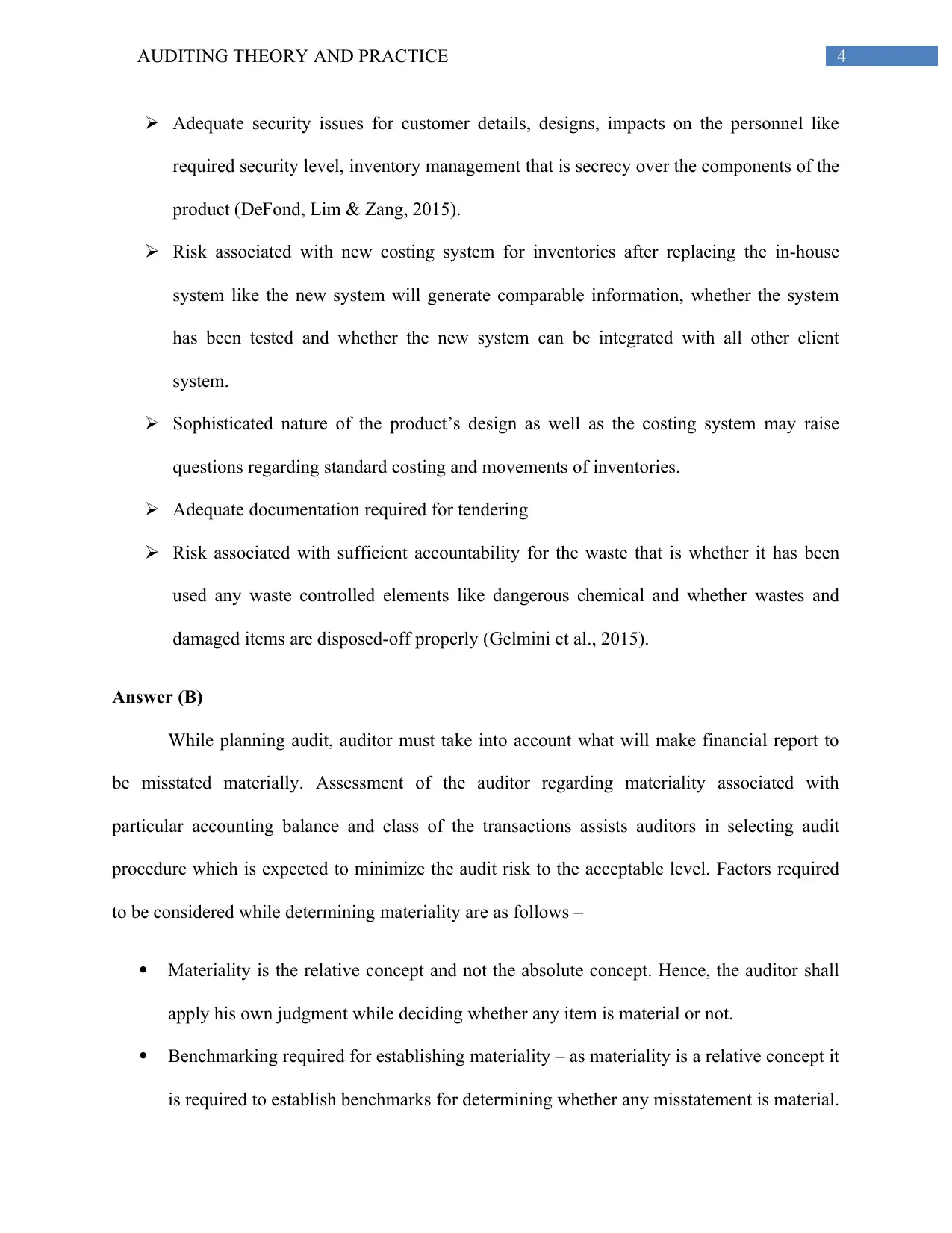
4AUDITING THEORY AND PRACTICE
Adequate security issues for customer details, designs, impacts on the personnel like
required security level, inventory management that is secrecy over the components of the
product (DeFond, Lim & Zang, 2015).
Risk associated with new costing system for inventories after replacing the in-house
system like the new system will generate comparable information, whether the system
has been tested and whether the new system can be integrated with all other client
system.
Sophisticated nature of the product’s design as well as the costing system may raise
questions regarding standard costing and movements of inventories.
Adequate documentation required for tendering
Risk associated with sufficient accountability for the waste that is whether it has been
used any waste controlled elements like dangerous chemical and whether wastes and
damaged items are disposed-off properly (Gelmini et al., 2015).
Answer (B)
While planning audit, auditor must take into account what will make financial report to
be misstated materially. Assessment of the auditor regarding materiality associated with
particular accounting balance and class of the transactions assists auditors in selecting audit
procedure which is expected to minimize the audit risk to the acceptable level. Factors required
to be considered while determining materiality are as follows –
Materiality is the relative concept and not the absolute concept. Hence, the auditor shall
apply his own judgment while deciding whether any item is material or not.
Benchmarking required for establishing materiality – as materiality is a relative concept it
is required to establish benchmarks for determining whether any misstatement is material.
Adequate security issues for customer details, designs, impacts on the personnel like
required security level, inventory management that is secrecy over the components of the
product (DeFond, Lim & Zang, 2015).
Risk associated with new costing system for inventories after replacing the in-house
system like the new system will generate comparable information, whether the system
has been tested and whether the new system can be integrated with all other client
system.
Sophisticated nature of the product’s design as well as the costing system may raise
questions regarding standard costing and movements of inventories.
Adequate documentation required for tendering
Risk associated with sufficient accountability for the waste that is whether it has been
used any waste controlled elements like dangerous chemical and whether wastes and
damaged items are disposed-off properly (Gelmini et al., 2015).
Answer (B)
While planning audit, auditor must take into account what will make financial report to
be misstated materially. Assessment of the auditor regarding materiality associated with
particular accounting balance and class of the transactions assists auditors in selecting audit
procedure which is expected to minimize the audit risk to the acceptable level. Factors required
to be considered while determining materiality are as follows –
Materiality is the relative concept and not the absolute concept. Hence, the auditor shall
apply his own judgment while deciding whether any item is material or not.
Benchmarking required for establishing materiality – as materiality is a relative concept it
is required to establish benchmarks for determining whether any misstatement is material.
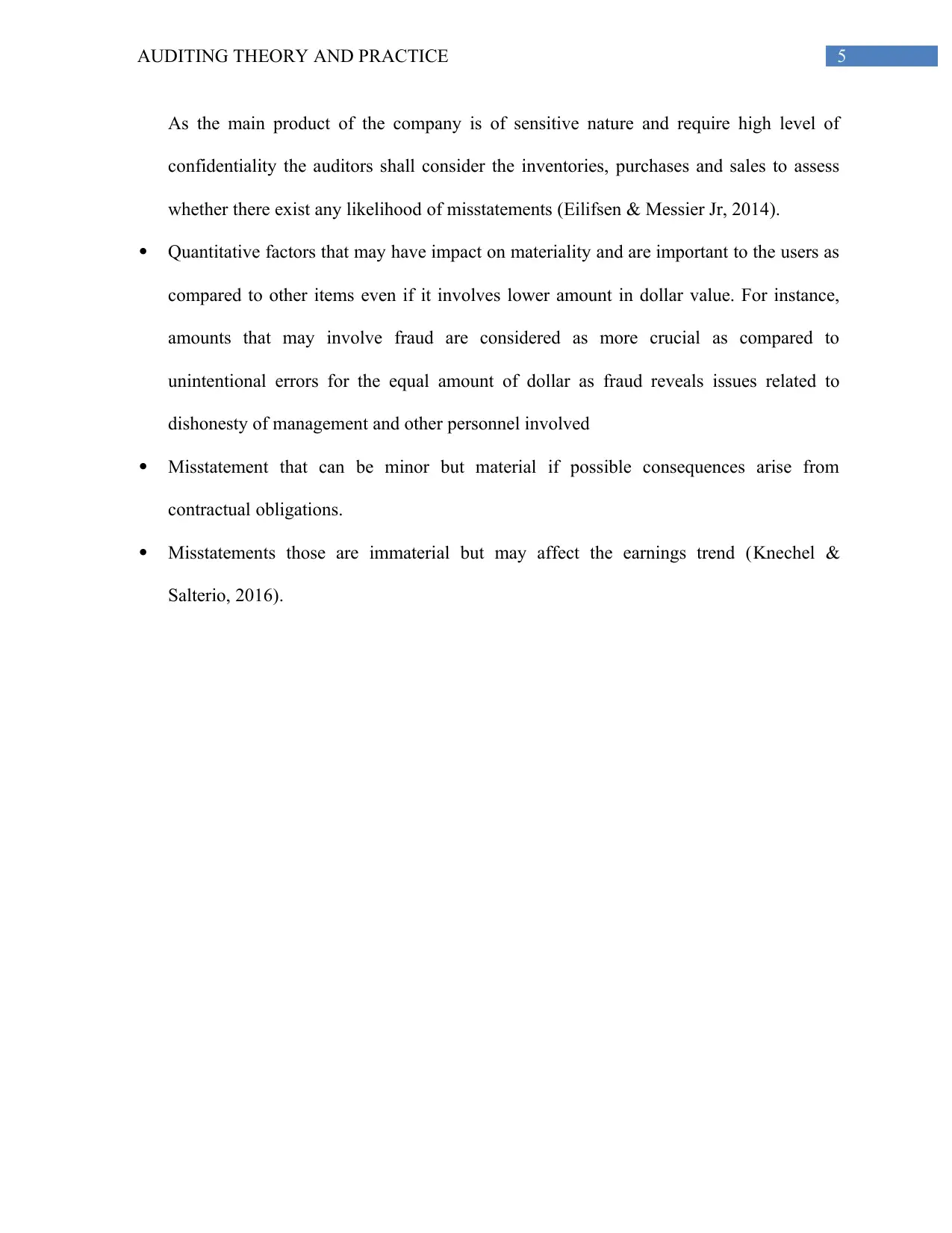
5AUDITING THEORY AND PRACTICE
As the main product of the company is of sensitive nature and require high level of
confidentiality the auditors shall consider the inventories, purchases and sales to assess
whether there exist any likelihood of misstatements (Eilifsen & Messier Jr, 2014).
Quantitative factors that may have impact on materiality and are important to the users as
compared to other items even if it involves lower amount in dollar value. For instance,
amounts that may involve fraud are considered as more crucial as compared to
unintentional errors for the equal amount of dollar as fraud reveals issues related to
dishonesty of management and other personnel involved
Misstatement that can be minor but material if possible consequences arise from
contractual obligations.
Misstatements those are immaterial but may affect the earnings trend (Knechel &
Salterio, 2016).
As the main product of the company is of sensitive nature and require high level of
confidentiality the auditors shall consider the inventories, purchases and sales to assess
whether there exist any likelihood of misstatements (Eilifsen & Messier Jr, 2014).
Quantitative factors that may have impact on materiality and are important to the users as
compared to other items even if it involves lower amount in dollar value. For instance,
amounts that may involve fraud are considered as more crucial as compared to
unintentional errors for the equal amount of dollar as fraud reveals issues related to
dishonesty of management and other personnel involved
Misstatement that can be minor but material if possible consequences arise from
contractual obligations.
Misstatements those are immaterial but may affect the earnings trend (Knechel &
Salterio, 2016).
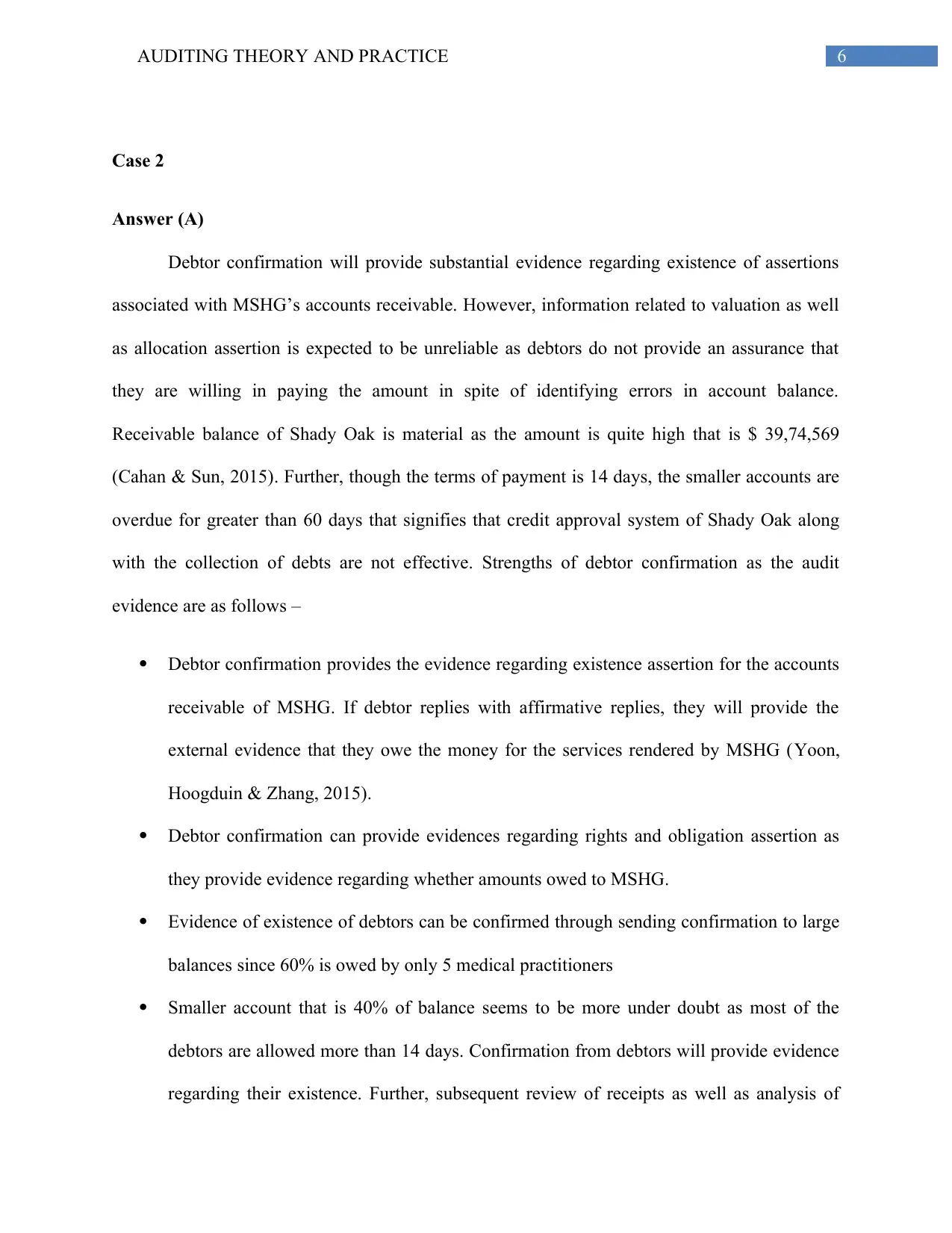
6AUDITING THEORY AND PRACTICE
Case 2
Answer (A)
Debtor confirmation will provide substantial evidence regarding existence of assertions
associated with MSHG’s accounts receivable. However, information related to valuation as well
as allocation assertion is expected to be unreliable as debtors do not provide an assurance that
they are willing in paying the amount in spite of identifying errors in account balance.
Receivable balance of Shady Oak is material as the amount is quite high that is $ 39,74,569
(Cahan & Sun, 2015). Further, though the terms of payment is 14 days, the smaller accounts are
overdue for greater than 60 days that signifies that credit approval system of Shady Oak along
with the collection of debts are not effective. Strengths of debtor confirmation as the audit
evidence are as follows –
Debtor confirmation provides the evidence regarding existence assertion for the accounts
receivable of MSHG. If debtor replies with affirmative replies, they will provide the
external evidence that they owe the money for the services rendered by MSHG (Yoon,
Hoogduin & Zhang, 2015).
Debtor confirmation can provide evidences regarding rights and obligation assertion as
they provide evidence regarding whether amounts owed to MSHG.
Evidence of existence of debtors can be confirmed through sending confirmation to large
balances since 60% is owed by only 5 medical practitioners
Smaller account that is 40% of balance seems to be more under doubt as most of the
debtors are allowed more than 14 days. Confirmation from debtors will provide evidence
regarding their existence. Further, subsequent review of receipts as well as analysis of
Case 2
Answer (A)
Debtor confirmation will provide substantial evidence regarding existence of assertions
associated with MSHG’s accounts receivable. However, information related to valuation as well
as allocation assertion is expected to be unreliable as debtors do not provide an assurance that
they are willing in paying the amount in spite of identifying errors in account balance.
Receivable balance of Shady Oak is material as the amount is quite high that is $ 39,74,569
(Cahan & Sun, 2015). Further, though the terms of payment is 14 days, the smaller accounts are
overdue for greater than 60 days that signifies that credit approval system of Shady Oak along
with the collection of debts are not effective. Strengths of debtor confirmation as the audit
evidence are as follows –
Debtor confirmation provides the evidence regarding existence assertion for the accounts
receivable of MSHG. If debtor replies with affirmative replies, they will provide the
external evidence that they owe the money for the services rendered by MSHG (Yoon,
Hoogduin & Zhang, 2015).
Debtor confirmation can provide evidences regarding rights and obligation assertion as
they provide evidence regarding whether amounts owed to MSHG.
Evidence of existence of debtors can be confirmed through sending confirmation to large
balances since 60% is owed by only 5 medical practitioners
Smaller account that is 40% of balance seems to be more under doubt as most of the
debtors are allowed more than 14 days. Confirmation from debtors will provide evidence
regarding their existence. Further, subsequent review of receipts as well as analysis of
Paraphrase This Document
Need a fresh take? Get an instant paraphrase of this document with our AI Paraphraser
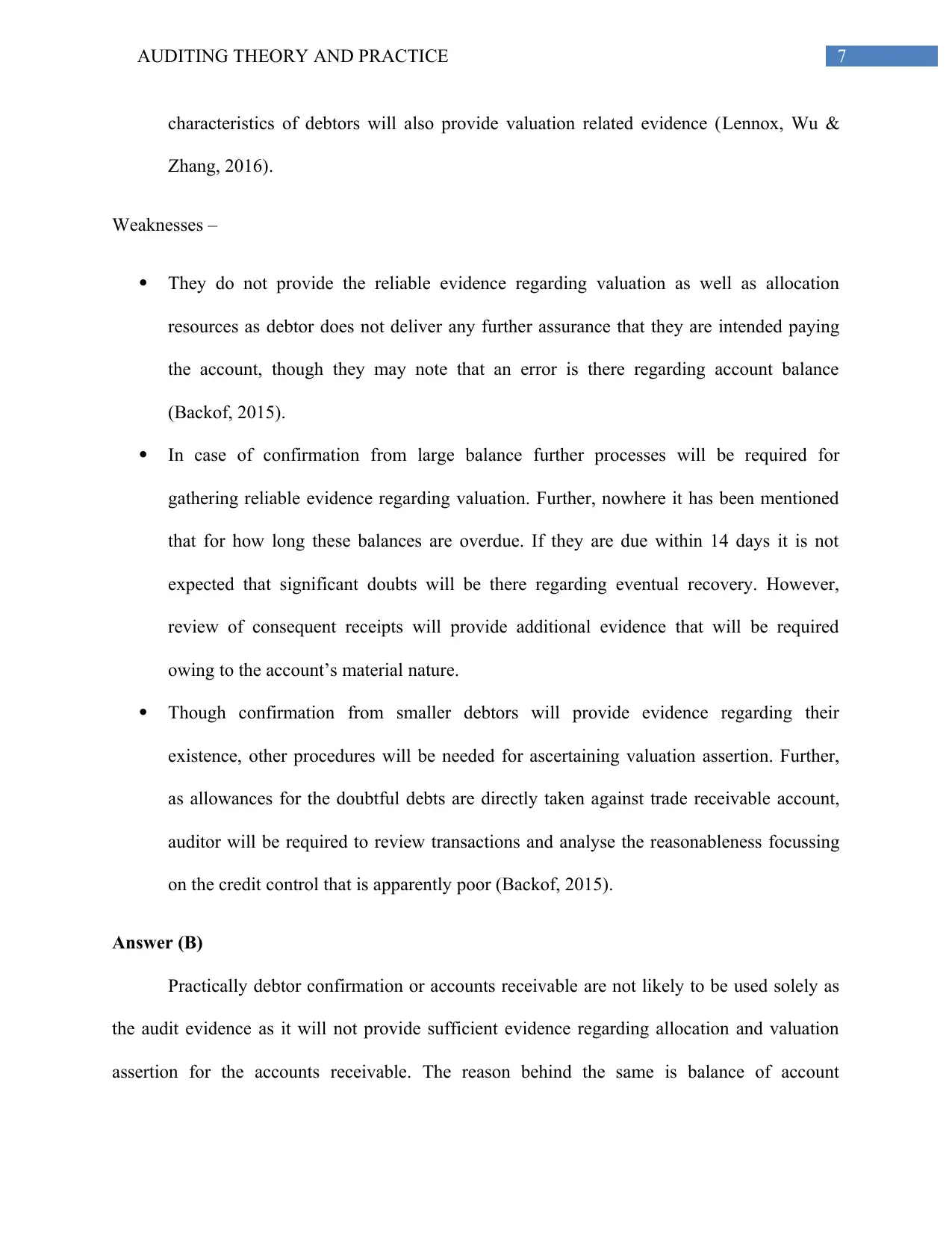
7AUDITING THEORY AND PRACTICE
characteristics of debtors will also provide valuation related evidence (Lennox, Wu &
Zhang, 2016).
Weaknesses –
They do not provide the reliable evidence regarding valuation as well as allocation
resources as debtor does not deliver any further assurance that they are intended paying
the account, though they may note that an error is there regarding account balance
(Backof, 2015).
In case of confirmation from large balance further processes will be required for
gathering reliable evidence regarding valuation. Further, nowhere it has been mentioned
that for how long these balances are overdue. If they are due within 14 days it is not
expected that significant doubts will be there regarding eventual recovery. However,
review of consequent receipts will provide additional evidence that will be required
owing to the account’s material nature.
Though confirmation from smaller debtors will provide evidence regarding their
existence, other procedures will be needed for ascertaining valuation assertion. Further,
as allowances for the doubtful debts are directly taken against trade receivable account,
auditor will be required to review transactions and analyse the reasonableness focussing
on the credit control that is apparently poor (Backof, 2015).
Answer (B)
Practically debtor confirmation or accounts receivable are not likely to be used solely as
the audit evidence as it will not provide sufficient evidence regarding allocation and valuation
assertion for the accounts receivable. The reason behind the same is balance of account
characteristics of debtors will also provide valuation related evidence (Lennox, Wu &
Zhang, 2016).
Weaknesses –
They do not provide the reliable evidence regarding valuation as well as allocation
resources as debtor does not deliver any further assurance that they are intended paying
the account, though they may note that an error is there regarding account balance
(Backof, 2015).
In case of confirmation from large balance further processes will be required for
gathering reliable evidence regarding valuation. Further, nowhere it has been mentioned
that for how long these balances are overdue. If they are due within 14 days it is not
expected that significant doubts will be there regarding eventual recovery. However,
review of consequent receipts will provide additional evidence that will be required
owing to the account’s material nature.
Though confirmation from smaller debtors will provide evidence regarding their
existence, other procedures will be needed for ascertaining valuation assertion. Further,
as allowances for the doubtful debts are directly taken against trade receivable account,
auditor will be required to review transactions and analyse the reasonableness focussing
on the credit control that is apparently poor (Backof, 2015).
Answer (B)
Practically debtor confirmation or accounts receivable are not likely to be used solely as
the audit evidence as it will not provide sufficient evidence regarding allocation and valuation
assertion for the accounts receivable. The reason behind the same is balance of account
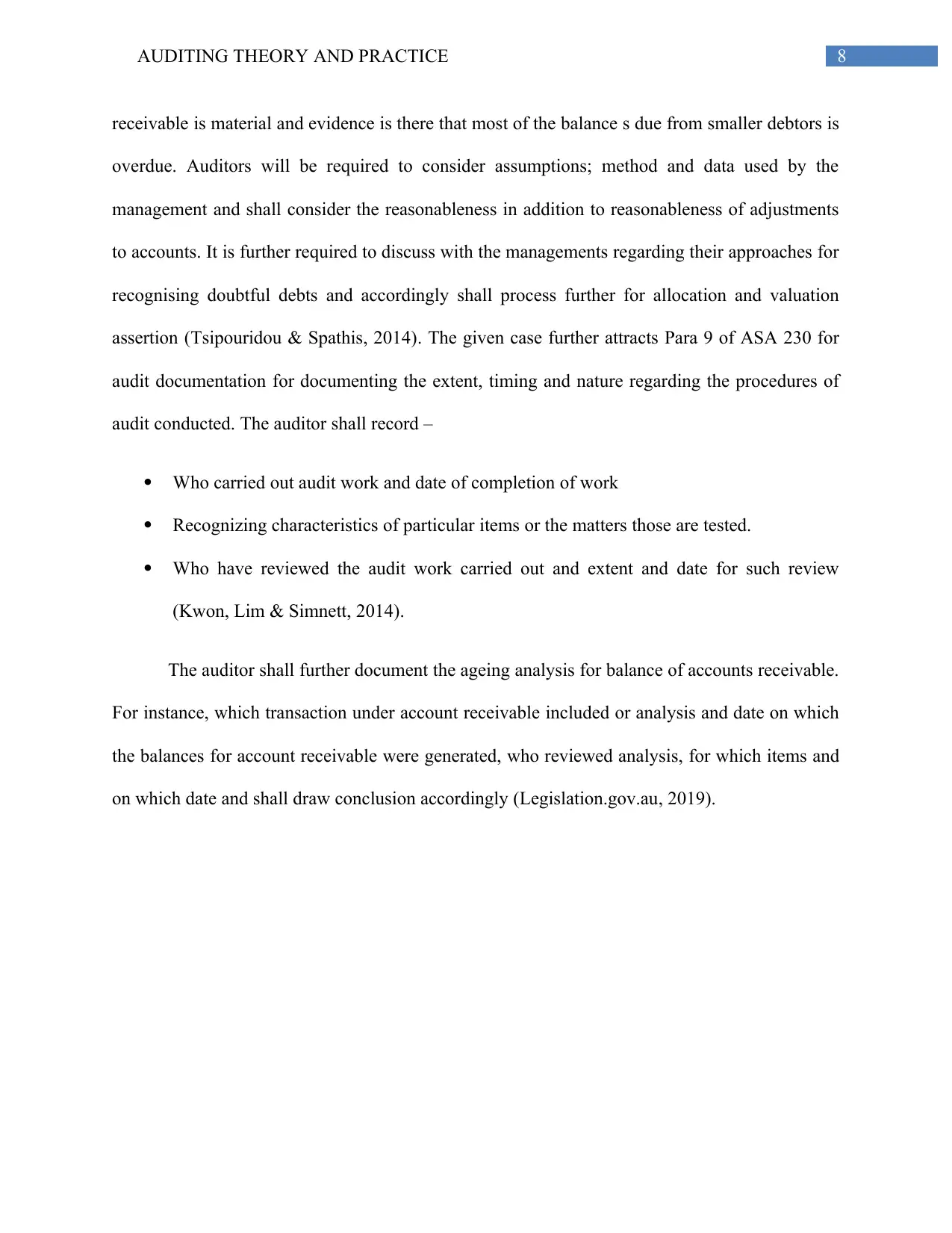
8AUDITING THEORY AND PRACTICE
receivable is material and evidence is there that most of the balance s due from smaller debtors is
overdue. Auditors will be required to consider assumptions; method and data used by the
management and shall consider the reasonableness in addition to reasonableness of adjustments
to accounts. It is further required to discuss with the managements regarding their approaches for
recognising doubtful debts and accordingly shall process further for allocation and valuation
assertion (Tsipouridou & Spathis, 2014). The given case further attracts Para 9 of ASA 230 for
audit documentation for documenting the extent, timing and nature regarding the procedures of
audit conducted. The auditor shall record –
Who carried out audit work and date of completion of work
Recognizing characteristics of particular items or the matters those are tested.
Who have reviewed the audit work carried out and extent and date for such review
(Kwon, Lim & Simnett, 2014).
The auditor shall further document the ageing analysis for balance of accounts receivable.
For instance, which transaction under account receivable included or analysis and date on which
the balances for account receivable were generated, who reviewed analysis, for which items and
on which date and shall draw conclusion accordingly (Legislation.gov.au, 2019).
receivable is material and evidence is there that most of the balance s due from smaller debtors is
overdue. Auditors will be required to consider assumptions; method and data used by the
management and shall consider the reasonableness in addition to reasonableness of adjustments
to accounts. It is further required to discuss with the managements regarding their approaches for
recognising doubtful debts and accordingly shall process further for allocation and valuation
assertion (Tsipouridou & Spathis, 2014). The given case further attracts Para 9 of ASA 230 for
audit documentation for documenting the extent, timing and nature regarding the procedures of
audit conducted. The auditor shall record –
Who carried out audit work and date of completion of work
Recognizing characteristics of particular items or the matters those are tested.
Who have reviewed the audit work carried out and extent and date for such review
(Kwon, Lim & Simnett, 2014).
The auditor shall further document the ageing analysis for balance of accounts receivable.
For instance, which transaction under account receivable included or analysis and date on which
the balances for account receivable were generated, who reviewed analysis, for which items and
on which date and shall draw conclusion accordingly (Legislation.gov.au, 2019).
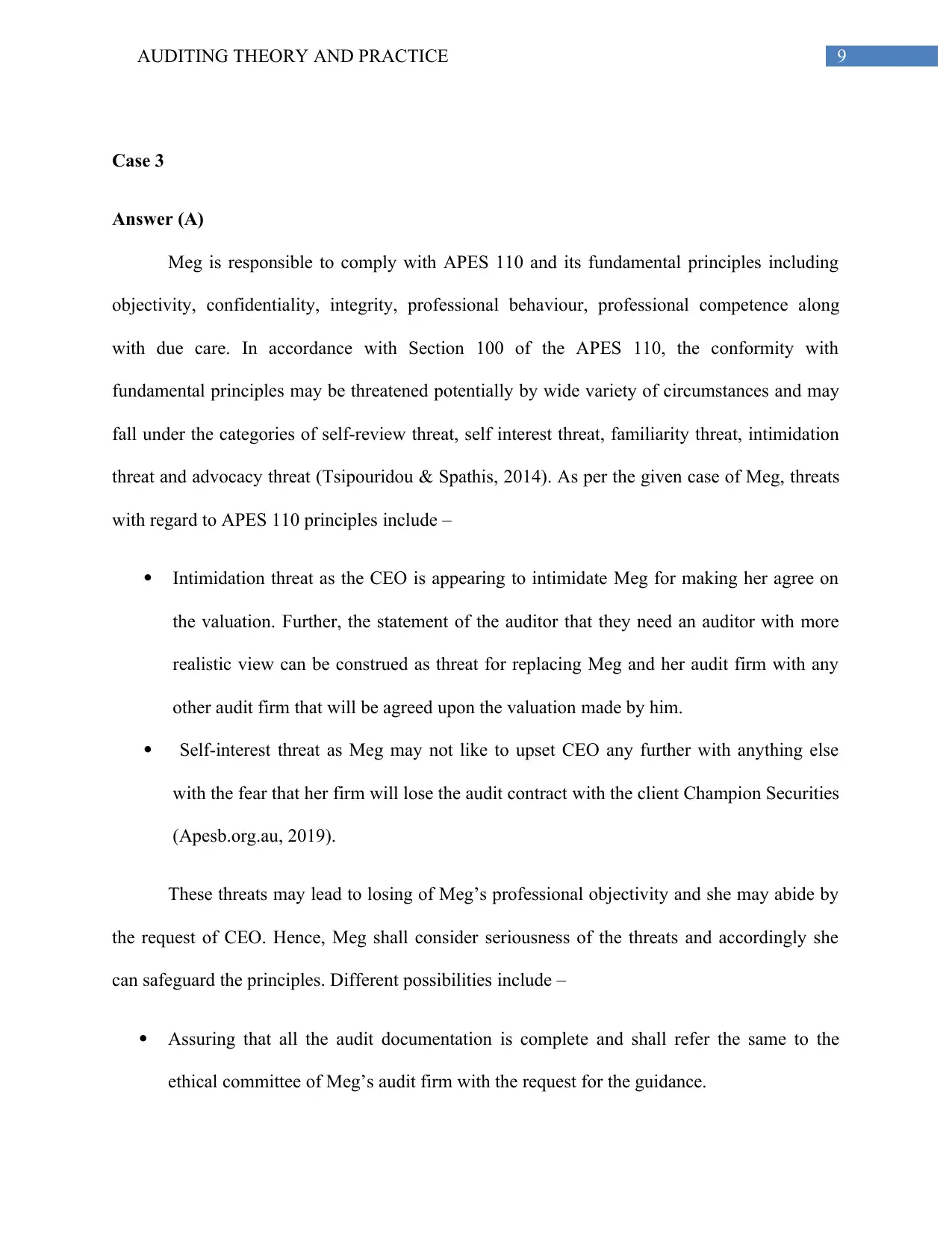
9AUDITING THEORY AND PRACTICE
Case 3
Answer (A)
Meg is responsible to comply with APES 110 and its fundamental principles including
objectivity, confidentiality, integrity, professional behaviour, professional competence along
with due care. In accordance with Section 100 of the APES 110, the conformity with
fundamental principles may be threatened potentially by wide variety of circumstances and may
fall under the categories of self-review threat, self interest threat, familiarity threat, intimidation
threat and advocacy threat (Tsipouridou & Spathis, 2014). As per the given case of Meg, threats
with regard to APES 110 principles include –
Intimidation threat as the CEO is appearing to intimidate Meg for making her agree on
the valuation. Further, the statement of the auditor that they need an auditor with more
realistic view can be construed as threat for replacing Meg and her audit firm with any
other audit firm that will be agreed upon the valuation made by him.
Self-interest threat as Meg may not like to upset CEO any further with anything else
with the fear that her firm will lose the audit contract with the client Champion Securities
(Apesb.org.au, 2019).
These threats may lead to losing of Meg’s professional objectivity and she may abide by
the request of CEO. Hence, Meg shall consider seriousness of the threats and accordingly she
can safeguard the principles. Different possibilities include –
Assuring that all the audit documentation is complete and shall refer the same to the
ethical committee of Meg’s audit firm with the request for the guidance.
Case 3
Answer (A)
Meg is responsible to comply with APES 110 and its fundamental principles including
objectivity, confidentiality, integrity, professional behaviour, professional competence along
with due care. In accordance with Section 100 of the APES 110, the conformity with
fundamental principles may be threatened potentially by wide variety of circumstances and may
fall under the categories of self-review threat, self interest threat, familiarity threat, intimidation
threat and advocacy threat (Tsipouridou & Spathis, 2014). As per the given case of Meg, threats
with regard to APES 110 principles include –
Intimidation threat as the CEO is appearing to intimidate Meg for making her agree on
the valuation. Further, the statement of the auditor that they need an auditor with more
realistic view can be construed as threat for replacing Meg and her audit firm with any
other audit firm that will be agreed upon the valuation made by him.
Self-interest threat as Meg may not like to upset CEO any further with anything else
with the fear that her firm will lose the audit contract with the client Champion Securities
(Apesb.org.au, 2019).
These threats may lead to losing of Meg’s professional objectivity and she may abide by
the request of CEO. Hence, Meg shall consider seriousness of the threats and accordingly she
can safeguard the principles. Different possibilities include –
Assuring that all the audit documentation is complete and shall refer the same to the
ethical committee of Meg’s audit firm with the request for the guidance.
Secure Best Marks with AI Grader
Need help grading? Try our AI Grader for instant feedback on your assignments.
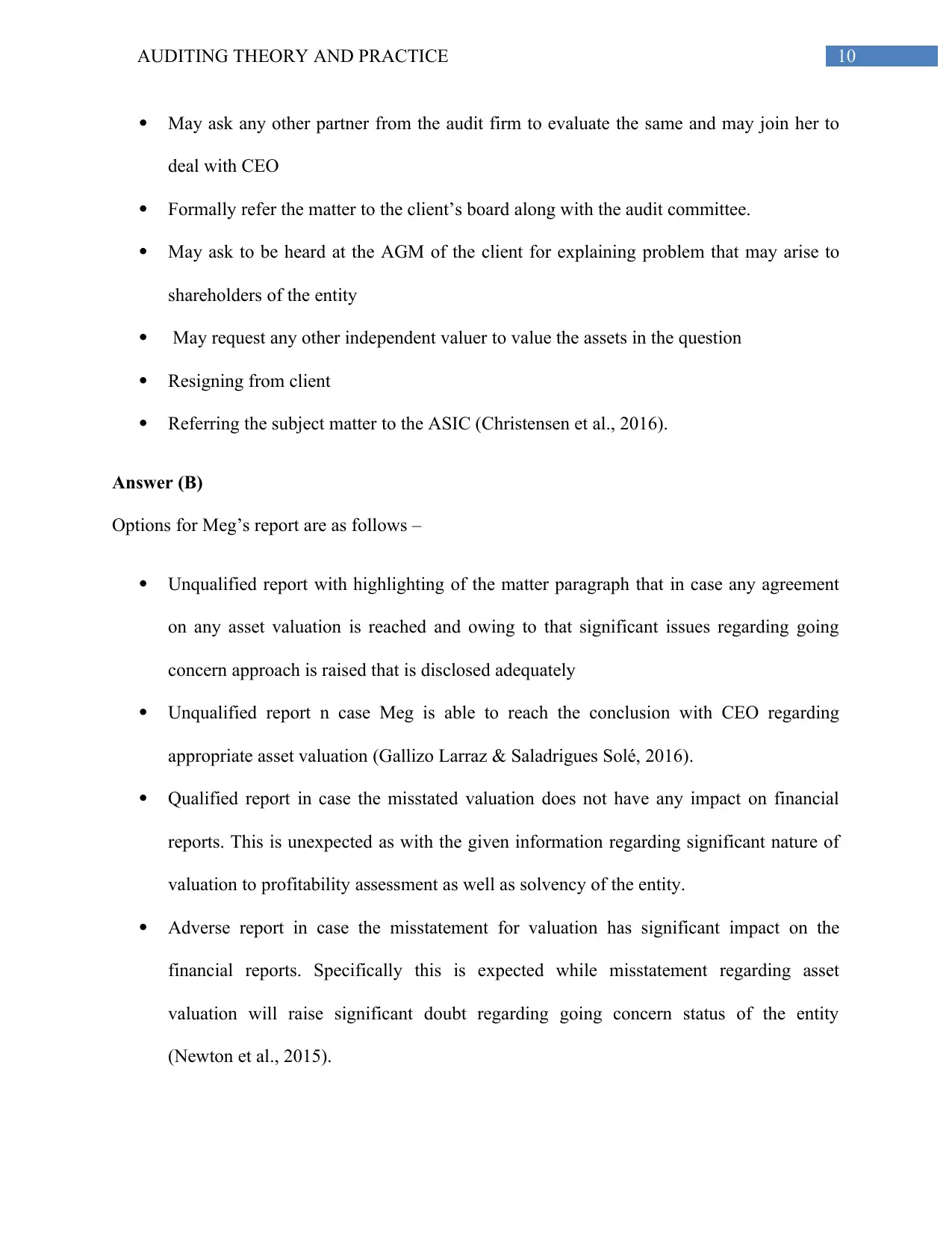
10AUDITING THEORY AND PRACTICE
May ask any other partner from the audit firm to evaluate the same and may join her to
deal with CEO
Formally refer the matter to the client’s board along with the audit committee.
May ask to be heard at the AGM of the client for explaining problem that may arise to
shareholders of the entity
May request any other independent valuer to value the assets in the question
Resigning from client
Referring the subject matter to the ASIC (Christensen et al., 2016).
Answer (B)
Options for Meg’s report are as follows –
Unqualified report with highlighting of the matter paragraph that in case any agreement
on any asset valuation is reached and owing to that significant issues regarding going
concern approach is raised that is disclosed adequately
Unqualified report n case Meg is able to reach the conclusion with CEO regarding
appropriate asset valuation (Gallizo Larraz & Saladrigues Solé, 2016).
Qualified report in case the misstated valuation does not have any impact on financial
reports. This is unexpected as with the given information regarding significant nature of
valuation to profitability assessment as well as solvency of the entity.
Adverse report in case the misstatement for valuation has significant impact on the
financial reports. Specifically this is expected while misstatement regarding asset
valuation will raise significant doubt regarding going concern status of the entity
(Newton et al., 2015).
May ask any other partner from the audit firm to evaluate the same and may join her to
deal with CEO
Formally refer the matter to the client’s board along with the audit committee.
May ask to be heard at the AGM of the client for explaining problem that may arise to
shareholders of the entity
May request any other independent valuer to value the assets in the question
Resigning from client
Referring the subject matter to the ASIC (Christensen et al., 2016).
Answer (B)
Options for Meg’s report are as follows –
Unqualified report with highlighting of the matter paragraph that in case any agreement
on any asset valuation is reached and owing to that significant issues regarding going
concern approach is raised that is disclosed adequately
Unqualified report n case Meg is able to reach the conclusion with CEO regarding
appropriate asset valuation (Gallizo Larraz & Saladrigues Solé, 2016).
Qualified report in case the misstated valuation does not have any impact on financial
reports. This is unexpected as with the given information regarding significant nature of
valuation to profitability assessment as well as solvency of the entity.
Adverse report in case the misstatement for valuation has significant impact on the
financial reports. Specifically this is expected while misstatement regarding asset
valuation will raise significant doubt regarding going concern status of the entity
(Newton et al., 2015).
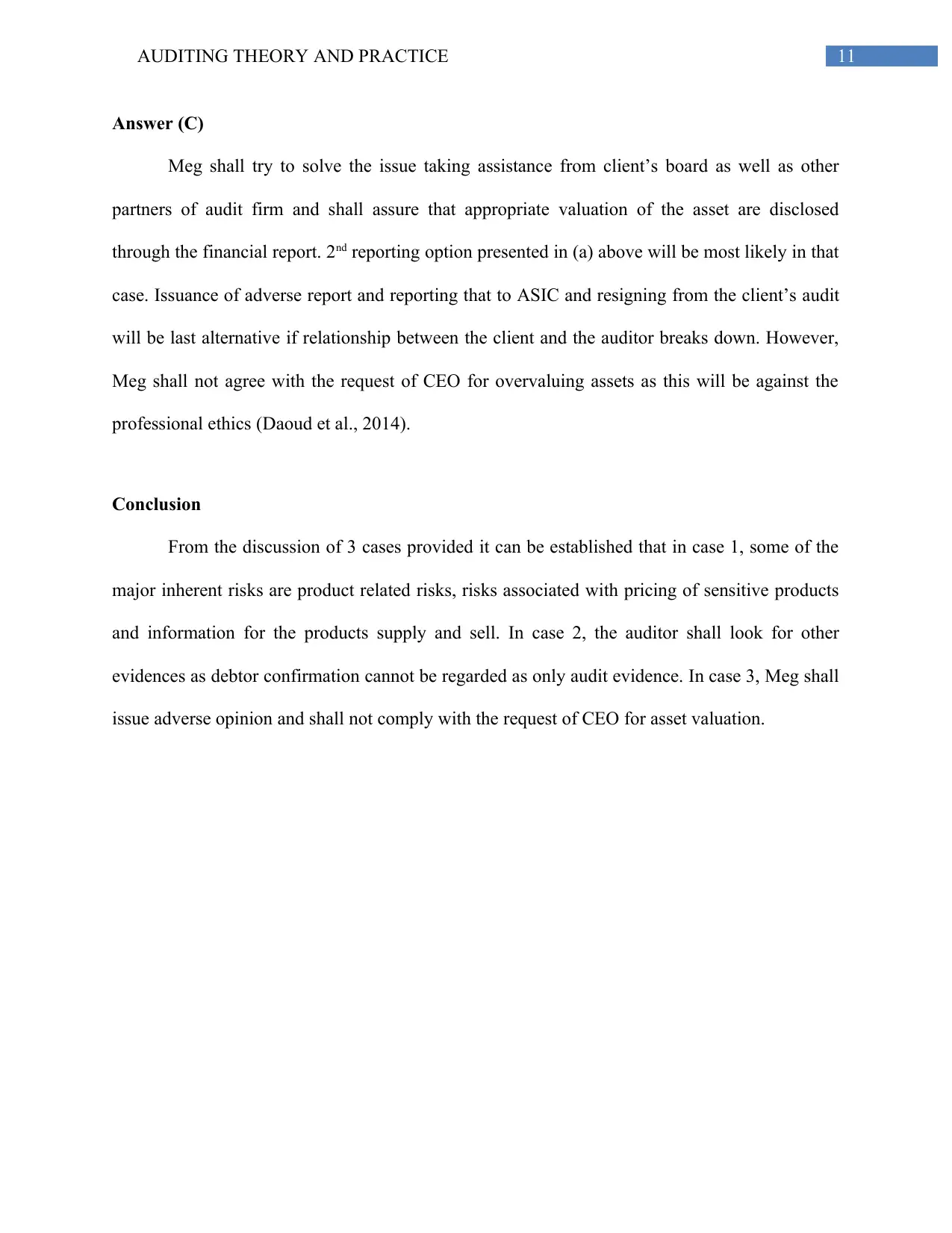
11AUDITING THEORY AND PRACTICE
Answer (C)
Meg shall try to solve the issue taking assistance from client’s board as well as other
partners of audit firm and shall assure that appropriate valuation of the asset are disclosed
through the financial report. 2nd reporting option presented in (a) above will be most likely in that
case. Issuance of adverse report and reporting that to ASIC and resigning from the client’s audit
will be last alternative if relationship between the client and the auditor breaks down. However,
Meg shall not agree with the request of CEO for overvaluing assets as this will be against the
professional ethics (Daoud et al., 2014).
Conclusion
From the discussion of 3 cases provided it can be established that in case 1, some of the
major inherent risks are product related risks, risks associated with pricing of sensitive products
and information for the products supply and sell. In case 2, the auditor shall look for other
evidences as debtor confirmation cannot be regarded as only audit evidence. In case 3, Meg shall
issue adverse opinion and shall not comply with the request of CEO for asset valuation.
Answer (C)
Meg shall try to solve the issue taking assistance from client’s board as well as other
partners of audit firm and shall assure that appropriate valuation of the asset are disclosed
through the financial report. 2nd reporting option presented in (a) above will be most likely in that
case. Issuance of adverse report and reporting that to ASIC and resigning from the client’s audit
will be last alternative if relationship between the client and the auditor breaks down. However,
Meg shall not agree with the request of CEO for overvaluing assets as this will be against the
professional ethics (Daoud et al., 2014).
Conclusion
From the discussion of 3 cases provided it can be established that in case 1, some of the
major inherent risks are product related risks, risks associated with pricing of sensitive products
and information for the products supply and sell. In case 2, the auditor shall look for other
evidences as debtor confirmation cannot be regarded as only audit evidence. In case 3, Meg shall
issue adverse opinion and shall not comply with the request of CEO for asset valuation.
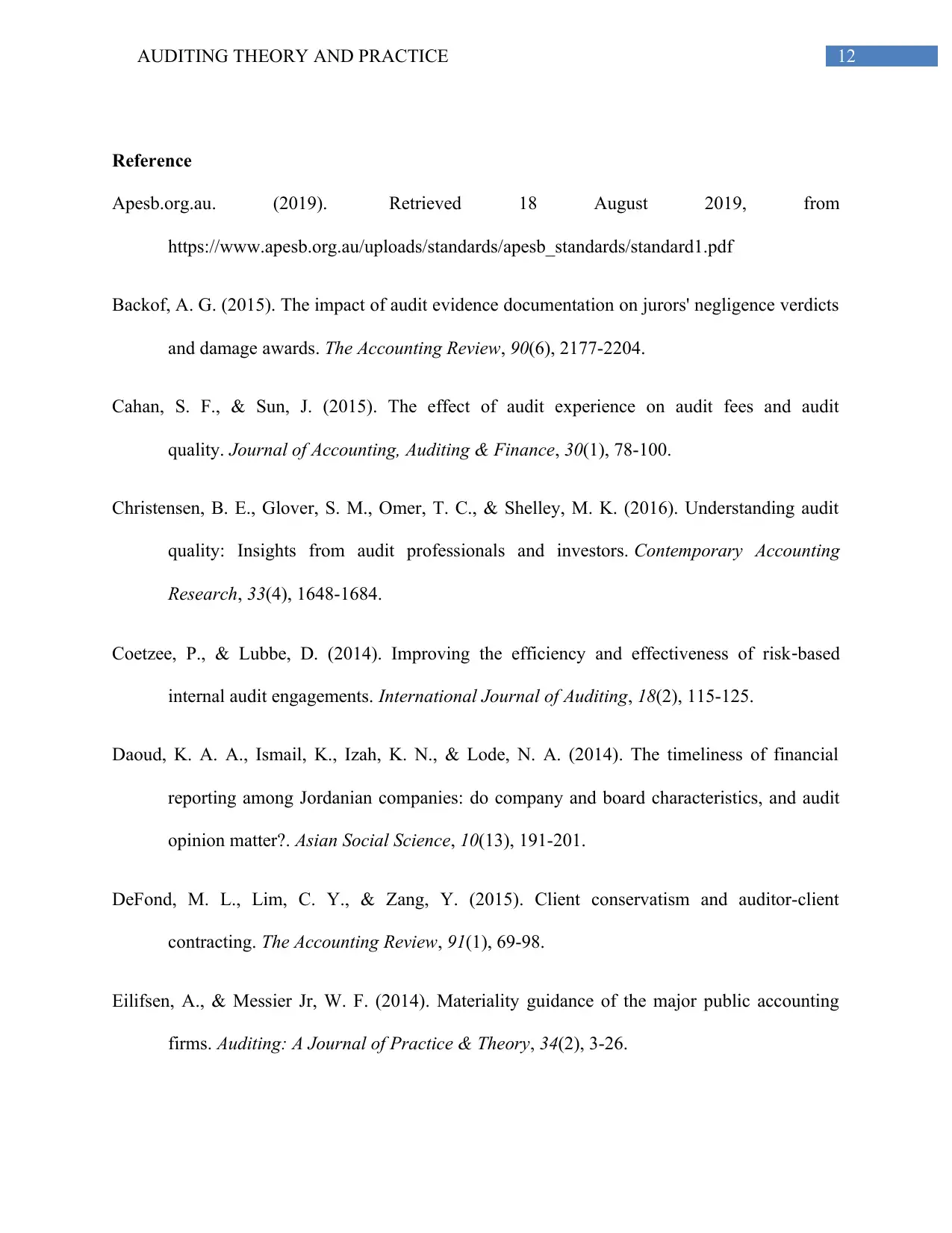
12AUDITING THEORY AND PRACTICE
Reference
Apesb.org.au. (2019). Retrieved 18 August 2019, from
https://www.apesb.org.au/uploads/standards/apesb_standards/standard1.pdf
Backof, A. G. (2015). The impact of audit evidence documentation on jurors' negligence verdicts
and damage awards. The Accounting Review, 90(6), 2177-2204.
Cahan, S. F., & Sun, J. (2015). The effect of audit experience on audit fees and audit
quality. Journal of Accounting, Auditing & Finance, 30(1), 78-100.
Christensen, B. E., Glover, S. M., Omer, T. C., & Shelley, M. K. (2016). Understanding audit
quality: Insights from audit professionals and investors. Contemporary Accounting
Research, 33(4), 1648-1684.
Coetzee, P., & Lubbe, D. (2014). Improving the efficiency and effectiveness of risk‐based
internal audit engagements. International Journal of Auditing, 18(2), 115-125.
Daoud, K. A. A., Ismail, K., Izah, K. N., & Lode, N. A. (2014). The timeliness of financial
reporting among Jordanian companies: do company and board characteristics, and audit
opinion matter?. Asian Social Science, 10(13), 191-201.
DeFond, M. L., Lim, C. Y., & Zang, Y. (2015). Client conservatism and auditor-client
contracting. The Accounting Review, 91(1), 69-98.
Eilifsen, A., & Messier Jr, W. F. (2014). Materiality guidance of the major public accounting
firms. Auditing: A Journal of Practice & Theory, 34(2), 3-26.
Reference
Apesb.org.au. (2019). Retrieved 18 August 2019, from
https://www.apesb.org.au/uploads/standards/apesb_standards/standard1.pdf
Backof, A. G. (2015). The impact of audit evidence documentation on jurors' negligence verdicts
and damage awards. The Accounting Review, 90(6), 2177-2204.
Cahan, S. F., & Sun, J. (2015). The effect of audit experience on audit fees and audit
quality. Journal of Accounting, Auditing & Finance, 30(1), 78-100.
Christensen, B. E., Glover, S. M., Omer, T. C., & Shelley, M. K. (2016). Understanding audit
quality: Insights from audit professionals and investors. Contemporary Accounting
Research, 33(4), 1648-1684.
Coetzee, P., & Lubbe, D. (2014). Improving the efficiency and effectiveness of risk‐based
internal audit engagements. International Journal of Auditing, 18(2), 115-125.
Daoud, K. A. A., Ismail, K., Izah, K. N., & Lode, N. A. (2014). The timeliness of financial
reporting among Jordanian companies: do company and board characteristics, and audit
opinion matter?. Asian Social Science, 10(13), 191-201.
DeFond, M. L., Lim, C. Y., & Zang, Y. (2015). Client conservatism and auditor-client
contracting. The Accounting Review, 91(1), 69-98.
Eilifsen, A., & Messier Jr, W. F. (2014). Materiality guidance of the major public accounting
firms. Auditing: A Journal of Practice & Theory, 34(2), 3-26.
Paraphrase This Document
Need a fresh take? Get an instant paraphrase of this document with our AI Paraphraser
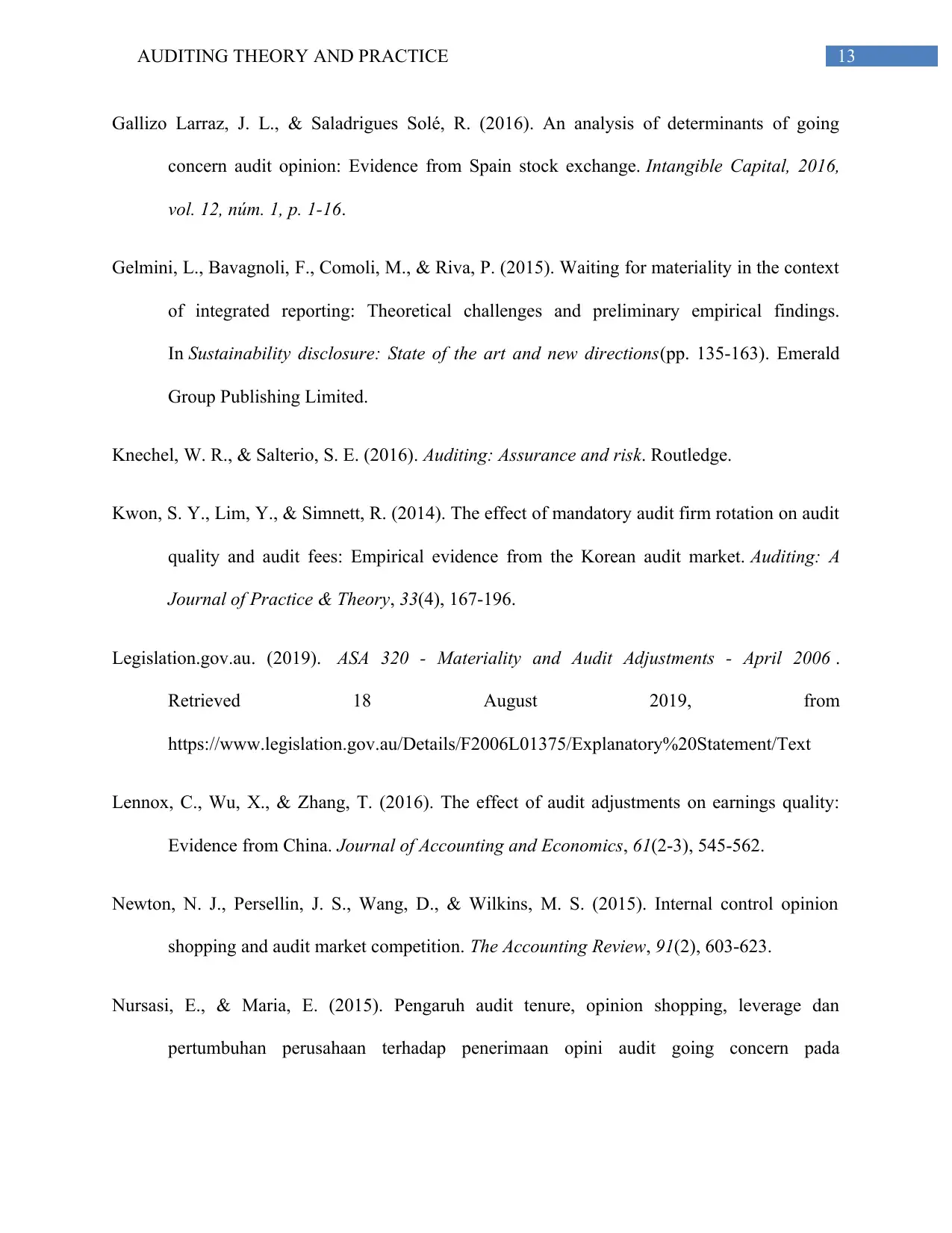
13AUDITING THEORY AND PRACTICE
Gallizo Larraz, J. L., & Saladrigues Solé, R. (2016). An analysis of determinants of going
concern audit opinion: Evidence from Spain stock exchange. Intangible Capital, 2016,
vol. 12, núm. 1, p. 1-16.
Gelmini, L., Bavagnoli, F., Comoli, M., & Riva, P. (2015). Waiting for materiality in the context
of integrated reporting: Theoretical challenges and preliminary empirical findings.
In Sustainability disclosure: State of the art and new directions(pp. 135-163). Emerald
Group Publishing Limited.
Knechel, W. R., & Salterio, S. E. (2016). Auditing: Assurance and risk. Routledge.
Kwon, S. Y., Lim, Y., & Simnett, R. (2014). The effect of mandatory audit firm rotation on audit
quality and audit fees: Empirical evidence from the Korean audit market. Auditing: A
Journal of Practice & Theory, 33(4), 167-196.
Legislation.gov.au. (2019). ASA 320 - Materiality and Audit Adjustments - April 2006 .
Retrieved 18 August 2019, from
https://www.legislation.gov.au/Details/F2006L01375/Explanatory%20Statement/Text
Lennox, C., Wu, X., & Zhang, T. (2016). The effect of audit adjustments on earnings quality:
Evidence from China. Journal of Accounting and Economics, 61(2-3), 545-562.
Newton, N. J., Persellin, J. S., Wang, D., & Wilkins, M. S. (2015). Internal control opinion
shopping and audit market competition. The Accounting Review, 91(2), 603-623.
Nursasi, E., & Maria, E. (2015). Pengaruh audit tenure, opinion shopping, leverage dan
pertumbuhan perusahaan terhadap penerimaan opini audit going concern pada
Gallizo Larraz, J. L., & Saladrigues Solé, R. (2016). An analysis of determinants of going
concern audit opinion: Evidence from Spain stock exchange. Intangible Capital, 2016,
vol. 12, núm. 1, p. 1-16.
Gelmini, L., Bavagnoli, F., Comoli, M., & Riva, P. (2015). Waiting for materiality in the context
of integrated reporting: Theoretical challenges and preliminary empirical findings.
In Sustainability disclosure: State of the art and new directions(pp. 135-163). Emerald
Group Publishing Limited.
Knechel, W. R., & Salterio, S. E. (2016). Auditing: Assurance and risk. Routledge.
Kwon, S. Y., Lim, Y., & Simnett, R. (2014). The effect of mandatory audit firm rotation on audit
quality and audit fees: Empirical evidence from the Korean audit market. Auditing: A
Journal of Practice & Theory, 33(4), 167-196.
Legislation.gov.au. (2019). ASA 320 - Materiality and Audit Adjustments - April 2006 .
Retrieved 18 August 2019, from
https://www.legislation.gov.au/Details/F2006L01375/Explanatory%20Statement/Text
Lennox, C., Wu, X., & Zhang, T. (2016). The effect of audit adjustments on earnings quality:
Evidence from China. Journal of Accounting and Economics, 61(2-3), 545-562.
Newton, N. J., Persellin, J. S., Wang, D., & Wilkins, M. S. (2015). Internal control opinion
shopping and audit market competition. The Accounting Review, 91(2), 603-623.
Nursasi, E., & Maria, E. (2015). Pengaruh audit tenure, opinion shopping, leverage dan
pertumbuhan perusahaan terhadap penerimaan opini audit going concern pada
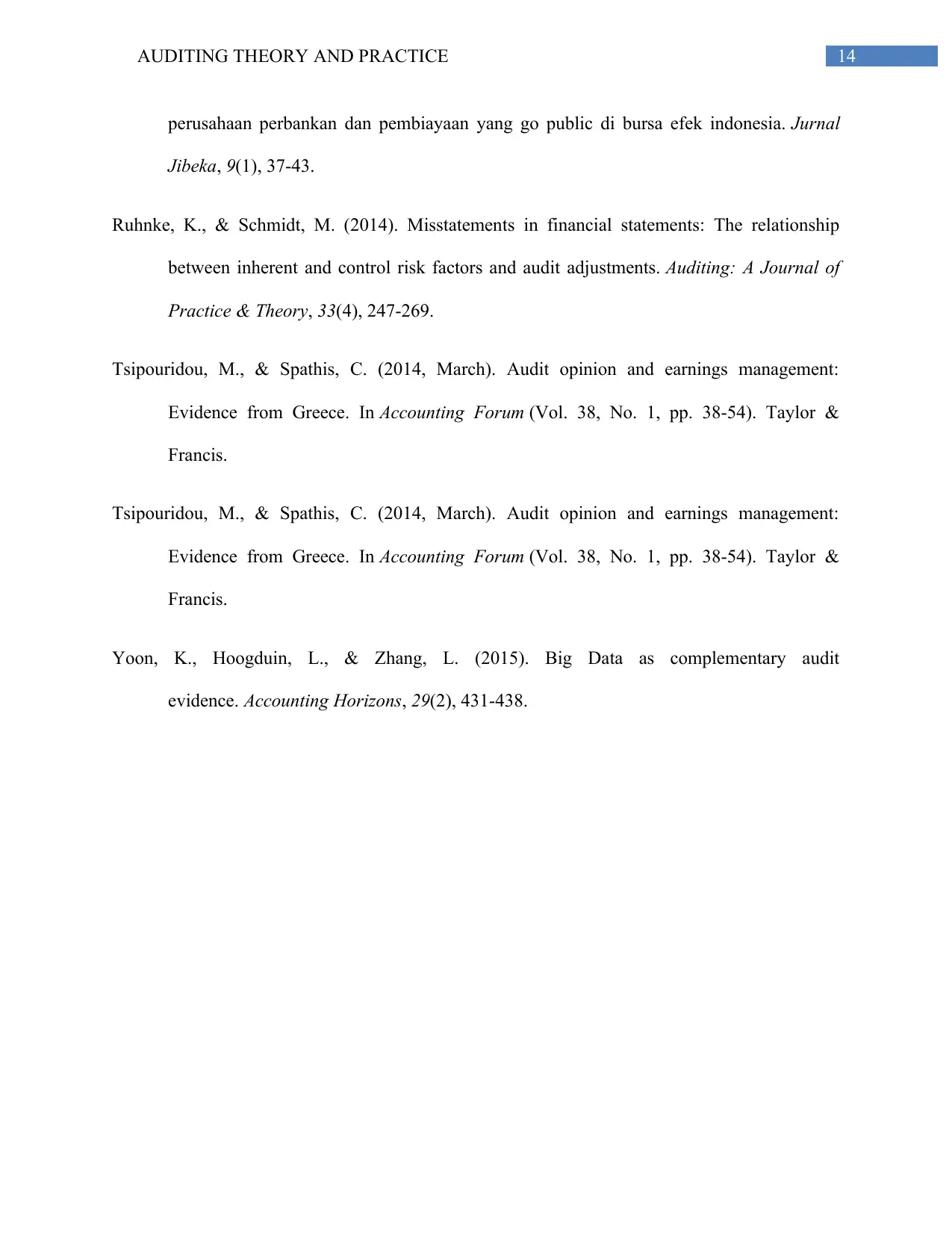
14AUDITING THEORY AND PRACTICE
perusahaan perbankan dan pembiayaan yang go public di bursa efek indonesia. Jurnal
Jibeka, 9(1), 37-43.
Ruhnke, K., & Schmidt, M. (2014). Misstatements in financial statements: The relationship
between inherent and control risk factors and audit adjustments. Auditing: A Journal of
Practice & Theory, 33(4), 247-269.
Tsipouridou, M., & Spathis, C. (2014, March). Audit opinion and earnings management:
Evidence from Greece. In Accounting Forum (Vol. 38, No. 1, pp. 38-54). Taylor &
Francis.
Tsipouridou, M., & Spathis, C. (2014, March). Audit opinion and earnings management:
Evidence from Greece. In Accounting Forum (Vol. 38, No. 1, pp. 38-54). Taylor &
Francis.
Yoon, K., Hoogduin, L., & Zhang, L. (2015). Big Data as complementary audit
evidence. Accounting Horizons, 29(2), 431-438.
perusahaan perbankan dan pembiayaan yang go public di bursa efek indonesia. Jurnal
Jibeka, 9(1), 37-43.
Ruhnke, K., & Schmidt, M. (2014). Misstatements in financial statements: The relationship
between inherent and control risk factors and audit adjustments. Auditing: A Journal of
Practice & Theory, 33(4), 247-269.
Tsipouridou, M., & Spathis, C. (2014, March). Audit opinion and earnings management:
Evidence from Greece. In Accounting Forum (Vol. 38, No. 1, pp. 38-54). Taylor &
Francis.
Tsipouridou, M., & Spathis, C. (2014, March). Audit opinion and earnings management:
Evidence from Greece. In Accounting Forum (Vol. 38, No. 1, pp. 38-54). Taylor &
Francis.
Yoon, K., Hoogduin, L., & Zhang, L. (2015). Big Data as complementary audit
evidence. Accounting Horizons, 29(2), 431-438.
1 out of 15
Related Documents
Your All-in-One AI-Powered Toolkit for Academic Success.
+13062052269
info@desklib.com
Available 24*7 on WhatsApp / Email
![[object Object]](/_next/static/media/star-bottom.7253800d.svg)
Unlock your academic potential
© 2024 | Zucol Services PVT LTD | All rights reserved.





